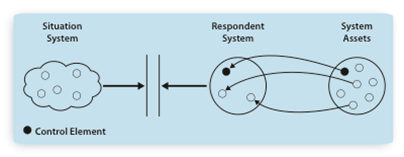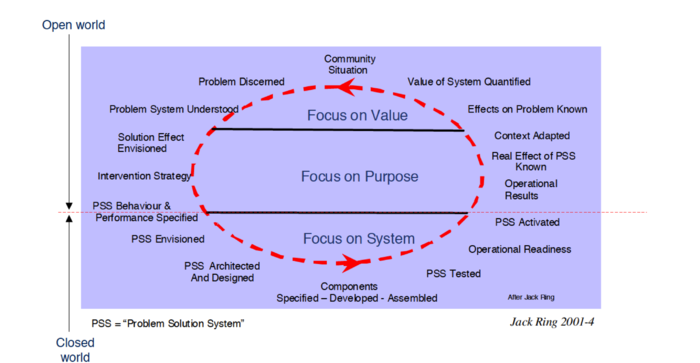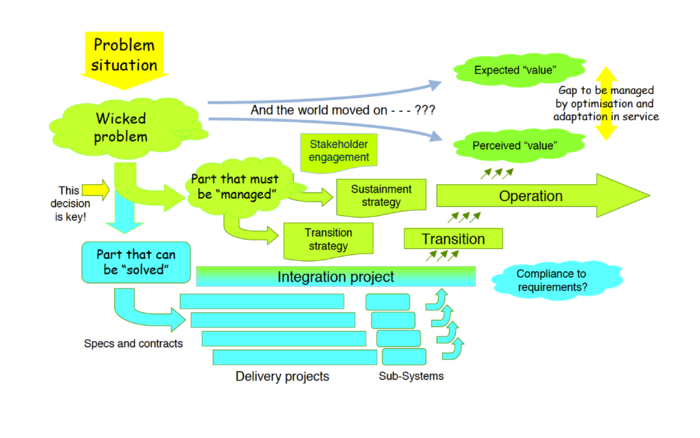Overview of the Systems Approach
This knowledge area (KA) considers how a systems approach relates to engineered systems and to systems engineering (SE). The article Applying the Systems Approach considers the dynamic aspects of how the approach is used and how this relates to elements of SE.
Systems Approach and Systems Engineering
The term Systems Approach is used by Systems Science authors to describe a systems thinking approach in particular considering issues outside of the boundary of the immediate system of interest, (Churchman 1979). The systems approach is essential when reductionist assumptions (i.e., the whole system has properties derived directly from the properties of their components) no longer apply to the system of interest (SoI); and when emergence and complexity at multiple levels of a system context necessitate a holistic approach.
When considering the Systems Approach for Engineered Systems practitioner should extend this idea to consider the “whole system, whole lifecycle, whole stakeholder community”, to ensure that the purpose of the system (or systemic intervention) is achieved sustainably without causing negative unintended consequences: in systems thinking terms, they can avoid “transferring the burden” to some other part of the environment unable to sustain that burden (Senge, 2006). They can also avoid the problem of “sub-optimization” that occurs when whole systems are not kept in mind in achieving the purpose of the system, (Sillitto 2012).
To what extent is Systems Engineering based on a Systems Approach and how well does it use the concepts, principles, patterns and representations of systems thinking ?
A Systems Science View
The Systems Approach and SE formed and grew somewhat independently. As discussed in Systems Science some parts of the systems movement have been developed as a reaction to the perceived limitations of Systems Engineering (Checkland 1999).
According to Ryan (2008):
Systems engineering has a history quite separate to the systems movement. Its closest historical link comes from the application of systems analysis techniques to parts of the systems engineering process. ...The recent popularity of the SoS buzzword in the systems engineering literature has prompted the expansion of systems engineering techniques to include methods that can cope with evolving networks of semi-autonomous systems. This has led many systems engineers to read more widely across the systems literature, and is providing a re-conceptualisation of systems engineering as part of the systems movement, despite its historical independence. This is reflected in the latest INCOSE hand-book [INCOSE 2011, page 52], which states “the systems engineering perspective is based on systems thinking”, which “recognizes circular causation, where a variable is both the cause and the effect of another and recognizes the primacy of interrelationships and non-linear and organic thinking—a way of thinking where the primacy of the whole is acknowledged (emphases added).
Thus, for many in the systems science community Systems Thinking is not naturally embedded in either SE definitions or practice.
A Systems Engineering View
Many SE authors see a clear link between SE and Systems Thinking. For example, (Hitchins, 2007) describes generic models for the application of Systems Thinking to [Engineered] System contexts. He suggests that these could form the foundation for descriptions and standards for the practices of Systems Engineering. Hitchins also proposes a set of “guiding principles which have been the foundations of SE, apparently since its inception” (Hitchins 2009):
- Principle A Systems Approach “SE is applied to a system-of-interest (SoI) in a wider systems context”
- Principle B Synthesis “SE must bring together a collection of parts to create whole system solutions”
- Principle C Holism “Always consider the consequences on the wider system when making decisions about the system elements”
- Principle D Organism Analogy “Always consider systems to have dynamic “living” behaviour in their environment”
- Principle E Adaptive Optimizing “Solve problems progressively over time”
- Principle F Progressive Entropy Reduction “Continue to make systems work over time, through maintenance, sustainment, upgrade activities.”
- Principle G Progressive Satisfying “A System will succeed only if it makes winners of its success-critical stakeholders, so the lifecycle of a system must be driven by how well its outputs contribute to stakeholder purpose”
Hitchins considers principles A-D as pillars of SE, they identify key aspects of Systems Thinking which should underpin the practice of SE. Principles E-G consider the dynamics of SE life cycle thinking, the why, when and how often of SE.
The following sections consider the Systems Approach to Engineered Systems against 4 sub themes.
Sub-theme 1: “Whole system”
The system coupling diagram (Lawson 2010), describes the scope of a systems approach to engineered systems.
- The situation system is the problem or opportunity either unplanned or planned. The situation may be natural, man-made a combination of both or a postulated situation used as a basis for deeper understanding and training (e.g. business games or military exercises).
- The respondent system is the system created to respond to the situation. The parallel bars indicate that this system interacts with the situation and transforms it to a new situation. Respondent systems have several names, project, program, mission, task force, or in a scientific context, experiment.
- System assets are the sustained assets of one or more enterprises to be used in response to situations. System assets must be adequately managed through-life to perform their function when instantiated in a respondent system. Examples include value-added products or services, facilities, instruments and tools, and abstract systems, such as theories, knowledge, processes and methods.
(Martin, 2004) describes seven types of system (“the seven samurai of systems engineering”), all of which system developers need to understand to develop successful systems:
- the context system,
- the intervention system,
- the realization system,
- the deployed system,
- collaborating systems,
- the sustainment system
- and competing systems.
He contends that all seven systems must be explicitly acknowledged and understood when engineering a solution for a complex adaptive situation.
These views, and others, describe one aspect of the systems approach when applied to engineered systems: it is applicable to understanding a problem; it organizes the resolution of that problem and creates and integrates any relevant assets and capabilities to enable that solution.
Sub-theme 2: Whole lifecycle
(Ring, 1998) provides a powerful framework for the continuing management and periodic upgrade of long-life and “immortal” systems. It also accurately represents the “continuous” or very rapid product launch and refresh cycle driven by market feedback and constant innovation that we see in most Product and Service system consumer markets.
Enterprise systems engineering can be regarded as multiple concurrent instances of this model, for different sub-sets of enterprise assets and services, in order to maintain a capability to pursue enterprise goals in a complex and dynamic external environment.
The dynamic nature of this cycle and its relationship to Life Cycle thinking is discussed in Applying the Systems Approach.
Sub-theme 3: “Whole Problem”
Identifying and Understanding Problems and Opportunities considers the nature of problem situations. It discusses the relationship between hard system and soft system views of problems and how they relate to Engineered Systems. Engineered systems are designed to operate with and add value to a containing social and/or ecological system. The scope of problems is captured by frameworks such as PESTLE (Gillespie 2007) or STEEPLED (social, technical, economic, environmental, political, legal, ethical and demographic).
The idea of a wicked problem (Rittel and Webber 1973) is also discussed. These problems cannot be quantified and solved in a traditional engineering sense.
(Sillitto, 2010) describes a lifecycle model in which the decision as to what parts of problems can be “solved” and what parts must be “managed” is the first key decision, and emphasizes the need for a solution approach that provides flexibility in the solution to match the level of uncertainty and change in the problem space and stakeholder expectations. It is now normal that “the problem changes over time” and value is determined by the perceptions of key stakeholders.
Thus, a Systems Approach can be taken for all levels of a Problem situation from individual technologies through to the complex socio technical issues which form the context of engineered systems development.
Sub-theme 4: Multi-Disciplinary
As discussed by (Sillitto 2012) the methods and thinking applied by many practicing Systems Engineers have become optimised to the domains of practice. While Systems Thinking concepts, patterns and methods are used widely they are not endemic in SE practice and SE practitioners find it difficult to share systems ideas with others involved in a systems approach. SEBoK Part 4: Applications of Systems Engineering describes “Traditional [product based] SE”, (Lawson 2010), and contrasts this with SE approaches applicable to Service, Enterprise and System of Systems Capability. These approaches require more use of problem exploration, broader solution context and purpose driven lifecycle thinking as discussed above.
How well does SE follow a Systems Approach?
From the above discussions there are three ways in which SE could make use of a Systems Approach:
- In its overall Problem Solving approach
- In the scope of problem and solution system contexts considered
- In the embedding of systems thinking and systems thinking tools, in all aspects of the conduct of that approach.
The current Systems Engineering standards and guides, as described in SEBOK Part 3: Systems Engineering and Management, encapsulate many of the elements of a Systems Approach. However, they tend to focus primarily on the development of system solutions while the wider purpose-driven thinking of a full systems approach, e.g. (Ring 1998), and the wider consideration of all relevant systems, e.g. (Martin 2004), is embedded in the acquisition and operational practices of their application domains. The inclusion of Systems Thinking in SE Competency Frameworks, e.g. (INCOSE 2010) illustrated a general move towards a desire for more use of Systems Thinking in SE practice. This is one of the motivations behind the Praxis Framework discussed in the Introduction to Part 2 and the inclusion of the Systems Approach Applied to Engineered Systems in the SEBoK. There is a wide stakeholder desire to achieve the benefits of a systems approach through the application of Systems Engineering, in contexts where current SE approaches are inadequate or irrelevant. Hence there is a need for a better articulation of “the Systems Approach” and how to apply it to non-traditional problems. By restating the full scope of a Systems Approach in the SE Body of Knowledge it is hoped that this will encourage other domains make use of and evolve SE practices.
Synthesis for SEBOK
The SEBoK systems approach uses the following activities:
- identify and understand the relationships between the potential problems and opportunities in a real world situation;
- fully understand and describe a selected problem or opportunity in the context of its wider system and its environment;
- synthesize viable system solutions to a selected problem or opportunity situation;
- analyze and choose between alternative solutions for a given time/cost/quality version of the problem;
- provide evidence that a solution has been correctly implemented and integrated; and
- deploy, sustain, and use a solution to help solve the problem (or exploit the opportunity).
All of the above are considered within a life cycle framework which may need concurrent, recursive and iterative applications of some or all of the systems approach.
When the systems approach is executed in the real world of an engineered system , a number of engineering and management disciplines emerge, including SE. SEBoK Parts 3 and 4 contain a detailed guide to SE with references to the principles of the systems approach as relevant.
SEBoK Part 5 provides a guide to the relationships between SE and the organizations, and Part 6 provides a guide to the relationship between SE and other disciplines. More detailed discussion of how the systems approach relates to these engineering and management disciplines is included in the Applying the Systems Approach topic in this knowledge area.
References
Works Cited
Checkland, P. 1999. Systems Thinking, Systems Practice. New York, NY, USA: John Wiley & Sons.
Churchman, C. West. 1979. "The Systems Approach and Its Enemies". New York: Basic Books.
Gillespie 2007: Foundations of Economics - Additional chapter on Business Strategy, Oxford University Press. http://www.oup.com/uk/orc/bin/9780199296378/01student/additional/page_12.htm.
Hitchins, D. 2009. "What are the General Principles Applicable to Systems?". INCOSE Insight. 12(4).
Hitchins, D, 2007. Systems Engineering, a 21st Century Systems Methodology, Wiley
INCOSE. 2011. INCOSE Systems Engineering Handbook: A Guide for System Life Cycle Processes and Activities, version 3.2.1. San Diego, CA, USA: International Council on Systems Engineering (INCOSE), INCOSE-TP-2003-002-03.2.1.
Lawson, H. 2010. A Journey Through the Systems Landscape. London, UK: College Publications, Kings College.
Martin, J, 2004. The Seven Samurai of Systems Engineering: Dealing with the Complexity of 7 Interrelated Systems. INCOSE 2004 - 14th Annual International Symposium Proceedings
Rittel, H. and M. Webber. 1973. "Dilemmas in a General Theory of Planning." In Policy Sciences. 4:155–169.
Ring, J., 1998. "A Value Seeking Approach to the Engineering of Systems." Proceedings of the IEEE Conference on Systems, Man, and Cybernetics. p. 2704-2708.
Ryan, A. 2008. “What is a Systems Approach?” Journal of Non-linear Science.
Senge, P.M. 1990, 2006. The Fifth Discipline: The Art and Practice of the Learning Organization. New York, NY, USA: Doubleday/Currency.
Sillitto, H, 2010. “Design principles for ultra-large scale systems”, proceedings of the INCOSE International Symposium, Chicago, July 2010, re-printed in "The Singapore Engineer" July 2011.
Sillitto, H G, 2012: " Integrating Systems Science, Systems Thinking, and Systems Engineering: understanding the differences and exploiting the synergies", Proceedings of the INCOSE International Symposium, Rome July 2012.
Primary References
Hitchins, D. 2009. "What are the General Principles Applicable to Systems?". INCOSE Insight. 12(4).
Checkland, P. 1999. Systems Thinking, Systems Practice. New York, NY, USA: John Wiley & Sons.
Senge, Peter. M. 1990. The Fifth Discipline: The Art and Practice of the Learning Organization. New York: Doubleday/Currency.
Additional References
Biggs, J.B. 1993. "From Theory to Practice: A Cognitive Systems Approach". Journal of Higher Education & Development.. Available from http://www.informaworld.com/smpp/content~db=all~content=a758503083.
Boardman, J. and B. Sauser 2008. Systems Thinking: Coping with 21st Century Problems. Boca Raton, FL, USA: CRC Press.
Edson, R. 2008. Systems Thinking. Applied. A Primer. Arlington, VA, USA: Applied Systems Thinking (ASysT) Institute, Analytic Services Inc.
Lawson, H. 2010. A Journey Through the Systems Landscape. London, UK: College Publications, Kings College.
Ring J. 2004. "Seeing an Enterprise as a System". INCOSE Insight. 6(2) (January 2004): 7-8.
SEBoK Discussion
Please provide your comments and feedback on the SEBoK below. You will need to log in to DISQUS using an existing account (e.g. Yahoo, Google, Facebook, Twitter, etc.) or create a DISQUS account. Simply type your comment in the text field below and DISQUS will guide you through the login or registration steps. Feedback will be archived and used for future updates to the SEBoK. If you provided a comment that is no longer listed, that comment has been adjudicated. You can view adjudication for comments submitted prior to SEBoK v. 1.0 at SEBoK Review and Adjudication. Later comments are addressed and changes are summarized in the Letter from the Editor and Acknowledgements and Release History.
If you would like to provide edits on this article, recommend new content, or make comments on the SEBoK as a whole, please see the SEBoK Sandbox.
blog comments powered by Disqus

